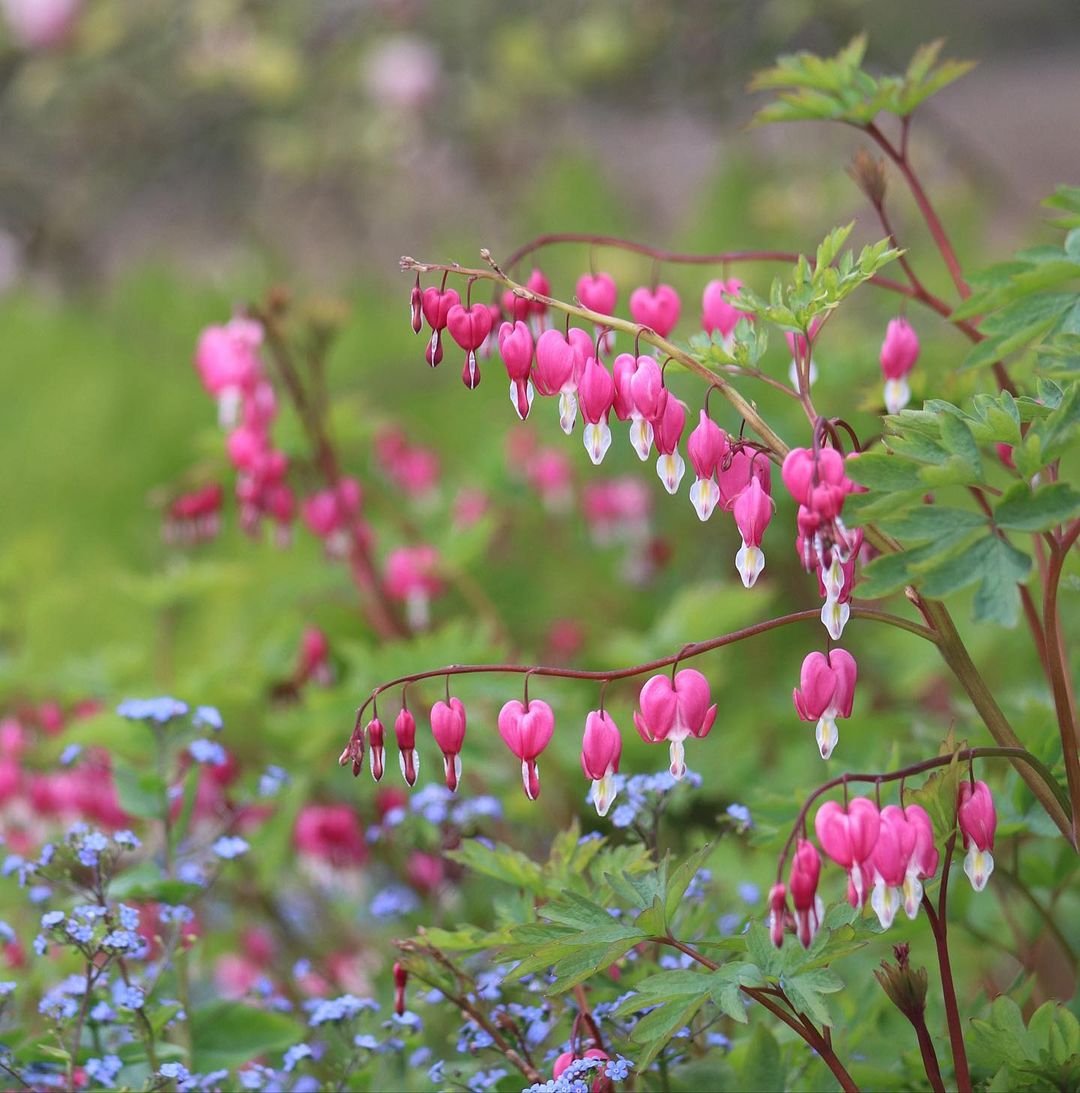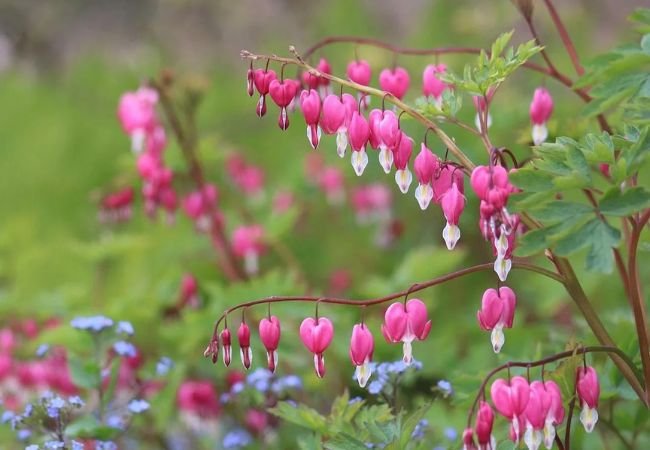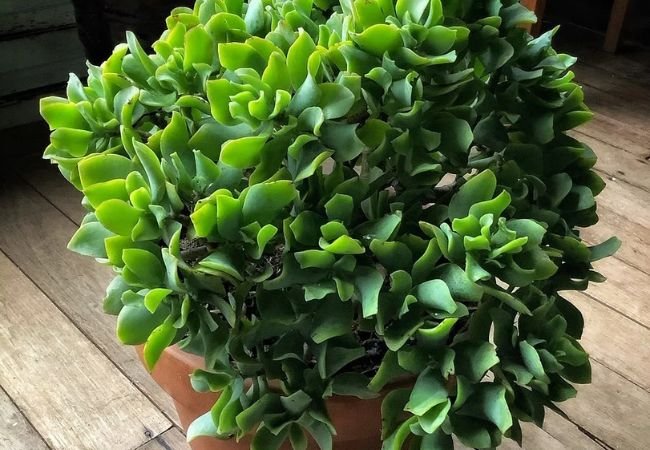Learn how to grow and care for the beautiful bleeding heart flower with this comprehensive guide. Get tips on planting, soil needs, sun exposure, watering, fertilizing, pruning, propagation and overwintering these delicate bloomers.
The bleeding heart flower (Dicentra spectabilis) is an old-fashioned charmer that brings romantic elegance to spring gardens. With its dangling heart-shaped flowers and fern-like foliage, it adds a touch of whimsy and nostalgia. While delightful, these beauties require a bit of know-how to thrive. This guide covers everything you need for successfully growing bleeding hearts.
About Bleeding Hearts

Bleeding hearts are herbaceous perennials native to eastern Asia. They go dormant in winter and emerge with new growth each spring. The arching stems reach 2-3 feet tall, bearing strings of puffy heart-shaped blooms in shades of pink, red and white. The heart “lockets” dangle below arching sprays of grayish-green foliage.
Bloom time typically runs from late spring through early summer, with the show often being done by mid-summer. After blooming finishes, the ferny foliage remains attractive for the rest of the season before dying back to the ground with cold weather.
In addition to the classic Dicentra spectabilis, there are a few other bleeding heart varieties to consider:
- ‘Alba’ – White flower form of the species
- ‘Aurora’ – Rose-pink blooms
- ‘Gold Heart’ – Golden-yellow foliage
- ‘Luxuriant’ – Larger flowers in crimson red
- ‘Valentine’ – Cherry red hearts
Where to Plant
When selecting a planting location, make sure to provide the conditions bleeding hearts need to flourish. They do best in partial to full shade, especially in hot summer climates. A few hours of morning sun is ok, but they’ll wilt in too much direct light.
Bleeding hearts require fertile, humus-rich, well-draining soil. They won’t tolerate soggy conditions, but do need consistent moisture. Amend garden beds with compost, aged manure or peat moss before planting to create an ideal environment.
These spring bloomers look lovely at the front of shaded borders, along walkways and paths, or in containers and woodland gardens. Try them as underplantings for trees and shrubs as well. The finely textured foliage combines beautifully with big, bold hosta leaves.
When to Plant
The best time to plant bare root or potted bleeding hearts is in early spring, as soon as the ground can be worked. This gives them time to get established before blooming.
In cold winter areas, it’s advisable to plant with the root ball 2-3 inches below the soil surface. This protects plants from frost heaving which can push shallow roots out of the ground over winter. Set crowns at the recommended planting depth and allow soil to settle naturally.
For potted plants, dig a hole twice as wide as the nursery container. Remove the plant from its pot, loosen any encircled roots and set it in at the same soil level it was growing in the pot. Backfill with soil and water thoroughly.
Space plants about 12-18 inches apart. Though bleeding hearts will spread gradually over time, they are not considered invasive.
How to Grow
After getting your bleeding hearts off to a good start, continue providing the following care:
Sun Exposure
Locate plants in areas that receive partial to full shade. In hot summer regions, peace at the bright end of partial shade. Too much sun leads to scorched foliage and stunted blooms.
Soil Needs
Bleeding hearts require fertile, humus-rich soil that drains well but never fully dries out. Amend beds annually with compost or aged manure to replenish nutrients.
Watering
Keep soil consistently moist, but not soaked. Provide about 1 inch of water weekly through spring and summer, adjusting as needed for rain. Never let the soil fully dry out.
Fertilizing
For best blooms, feed bleeding hearts in early spring when new growth emerges. Use an all-purpose fertilizer or side dress with compost or aged manure. Avoid high-nitrogen fertilizers which promote lush foliage at the expense of flowers.
Support
The tall flower spikes can flop over as they get heavy with blooms. Insert peony rings or stake plants when they’re 12 inches tall to keep stems nicely upright.
Mulching
Apply a 2-3 inch layer of shredded bark or leaf litter annually after the ground thaws in spring. This conserves moisture and suppresses weeds while letting the soil warm up gradually.
Pruning
After blooms fade in early summer, cut off spent flower stems all the way to the ground. Leave the lovely foliage in place through fall to photosynthesize for next year’s show.
Dividing
While not absolutely necessary, dividing bleeding hearts every 3-4 years reinvigorates growth and blooming. Do this in early spring when you first see new shoots emerging.
Carefully dig up the entire root clump, rinse off soil, and use a sharp knife to pry apart the tuberous, knobby root mass into separate pieces. Make sure each division has plenty of buds on the crown. Replant divisions at the proper depth and water well
Propagation
In addition to division, bleeding hearts can be propagated by seed:
- Allow some pods to form after blooming and mature fully on the plant
- Harvest dried pods when they turn papery and split
- Remove seeds from pods and store in a cool, dry place until ready to plant
- Sow seeds 1/2 inch deep in containers or directly in garden beds in fall
- Seedlings should emerge the following spring
Be patient, as it generally takes 2+ years for seed-grown plants to flower.
Pests and Problems
Luckily, bleeding hearts aren’t plagued by too many issues. However, keep an eye out for the following:
- Slugs and snails – These slimy pests can chew holes in foliage. Use diatomaceous earth, copper barriers or baits.
- Leaf miner – Tunnels or trails on leaves are a sign of these insect larvae. Remove affected foliage.
- Botrytis blight – Grayish fuzz on foliage caused by a fungus that thrives in cool, damp conditions. Improve air circulation and avoid wetting foliage.
- Verticillium wilt – Yellowing, wilting and plant decline caused by a soilborne fungus. Destroy affected plants.
- Viral diseases – Streaked or mottled leaves, stunted growth. No cure, prevent spread to other plants.
Winter Protection
Once bleeding heart foliage dies back in fall, cut off any remaining stems at ground level. Apply a 2-4 inch layer of shredded bark, leaves, or straw over the dormant root zone for winter protection. This mulch helps insulate crowns from harsh freezing and thawing cycles.
In colder climates, it’s wise to grow bleeding hearts in containers that can be moved into an unheated garage or shed for winter. This prevents frost heaving that can push crowns out of the ground.
With some basic care and the right growing conditions, bleeding hearts will reliably return each spring with their vibrant blooms. Cherish these elegant charmers as fleeting reminders to enjoy the season!








Leave a Reply